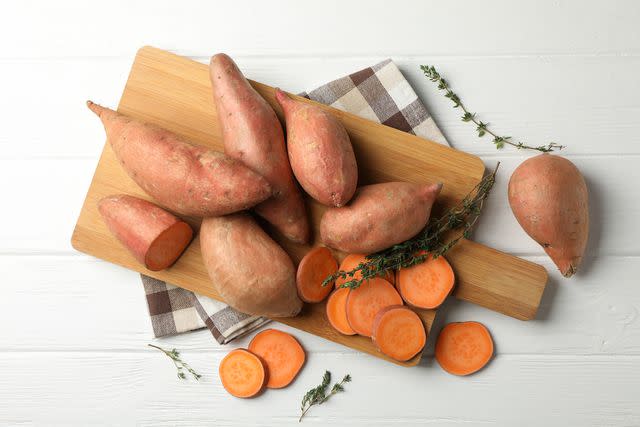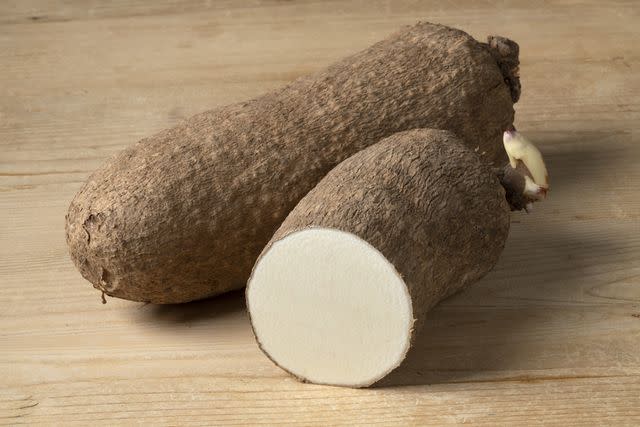What's the Difference Between Yams and Sweet Potatoes?
Yes, there is a difference—sweet potatoes and true yams are completely different vegetables.
While many people in the United States use the terms “sweet potato” and “yam” interchangeably, they are, in fact, totally different vegetables. The two belong to different plant families—sweet potatoes are a tuber in the Convolvulaceae (morning glory) family, while yams are a tuber in the Dioscoreaceae family—and are actually not all that similar. The “yams” most commonly sold in American grocery stores, including the ones you’d use to make candied yams, are actually orange sweet potatoes.
So, what makes a yam different from a sweet potato?

What Is a Yam?
A yam is a starchy root vegetable in the Dioscoreaceae family that has white or purple flesh with a rough, bark-like skin and a neutral, sometimes earthy, flavor.
What Is a Sweet Potato?
A sweet potato is a root vegetable in the Convolvulaceae family that has white, purple, or orange flesh with a creamy texture and sugary-sweet flavor.
How Are Yams and Sweet Potatoes Different?
Sweet potatoes are native to Central and South America, while yams are native to Asia and Africa, the latter of which produces most of the world’s supply. “One of the main differences is the origin,” says Shayn Prapaisilp of Global Foods Market in Kirkwood, Missouri. “Sweet potatoes are a new world food, so Central and South America. True yams have their origin in Africa, and they are found mostly and consumed in West Africa and parts of East Asia.”
Sweet potatoes and yams also differ in terms of taste, texture, and appearance.

Taste
Sweet potatoes are, well, sweet. True yams taste completely different than sweet potatoes—they have a more neutral, earthy flavor, closer to a russet potato, and can be toxic if eaten raw. “When cooked, African yams are starchy and taste like a dryer dense potato,” says Sola Ajao, head chef and owner of Destiny African Market in Randolph, Massachusetts. “African yams offer a unique taste that is not sugary.”
Texture
Sweet potatoes have a soft to firm texture with a creamier interior. Yams are usually starchy and dry with a rough, bumpy outer skin—it’s often compared to tree bark. “The skin of African yams have a very rough texture,” Ajao says. “Once the inside is cooked, it softens but still maintain its shape.”
Appearance
Dark-skinned, orange-fleshed sweet potatoes are most common in the United States, but you'll also find varieties with white or purple flesh. Yams typically have brown or black skin with white flesh, although ube, a sweet purple yam popular in Filipino cooking, has purple flesh and dark skin. Sweet potatoes typically weigh less than a pound, while true yams are often much larger—they can weigh up to 100 pounds and grow to over 6 feet in length.
Buying and Storing Yams and Sweet Potatoes
If you’re shopping for true yams, your best bet is to head to a specialty grocery or international market, particularly African and Asian grocery stores. When purchasing yams or sweet potatoes, look for ones that are firm to the touch, and avoid any with blemishes or dark spots. “The best indicator of a good yam is how it feels,” Ajao says. “When it is sturdy and hard to the touch, you have yourself a great yam.”
Since yams have such a thick, bark-like skin, they will generally keep much longer than other fresh produce. But to maintain their freshness, Ajao recommends storing yams in a cool, dry environment out of direct light.
How to Cook with Yams
Since they don’t have the sugary-sweet flavor of sweet potatoes, true yams shouldn’t be candied. Instead, Prapaisilp recommends treating them like a conventional potato, such as a russet potato, versus a sweet potato. “A yam is almost like a russet potato, so it’s much harder and will take a little bit more cooking time versus sweet potatoes, which are creamier,” he says.
Ajao recommends frying, boiling, or roasting yams, or using them in a number of traditional African recipes, including varieties of the iconic dish fufu. “In Africa, there are many fun and delicious ways to prepare yam, such as pounded yam (a nuanced fufu variant), yam porridge (a heartwarming delicacy), and yam flour (amala), the foundation for another variety of fufu,” she says.
How to Cook with Sweet Potatoes
Sweet potatoes are good for much more than just candied yams. Baking is one of the most popular methods for cooking sweet potatoes, but they’re also easy to boil, fry, or pressure cook. Go sweet with a classic Sweet Potato Casserole with Pecan Topping or simple Sweet Potato Brownies, or take them in a savory direction with Spicy Scalloped Sweet Potatoes, Sweet Potato Peanut Stew or a quick and easy Sweet Potato Hash.
For more Better Homes & Gardens news, make sure to sign up for our newsletter!
Read the original article on Better Homes & Gardens.

